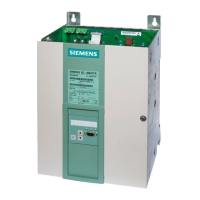Siemens Energy & Automation 9-17
SIMOREG DC Master Base Drive Panel Operating Instructions
Fault Description
No.
Cause as a function of fault value
(r047.001, r949.001 or r949.009 with acknowledged error)
Further information (r047.002 to r047.016)
20 Current limit is too low
(With speed controller optimization run: Less than 30% or 45% of P100 (I
A,motor
) + the armature current required for zero
speed,
With optimization run for friction moment and moment of inertia compensation: Less than 20% of P100 (I
A, motor
) + the
armature current required for a steady-state speed corresponding to 10% of maximum speed)
21 Field weakening range is too wide (n
act
< +7% n
max
produces |EMF| > 54% setpoint EMF)
(setpoint EMF= K289= P101 – P100
*
P110)
Possible cause:
• Maximum speed setting is incorrect
• Pulse encoder parameters are incorrect (P140 to P143)
• Parameters for tachometer adaptation are incorrect (P741)
• Setpoint EMF is not correct (P101, P100, P110)
• Caution:
Even a high absolute negative actual speed value can produce an | EMF | of > 54% setpoint EMF
22 With speed controller optimization run:
With an acceleration current equaling 20% or 30% of P100 (I
A, motor
) + armature current required for zero speed or
With optimization run for friction moment and moment of inertia compensation:
With an acceleration current equaling the current required to achieve a steady-state speed of 10% of maximum speed +
20% of P100 (I
A, motor
), the maximum speed cannot be reached within 45s +7%
Possible cause:
• Centrifugal mass is too large
• Drive is blocked, heavily speed-dependent or excessively high load torque
• “Active” load is attempting to maintain a certain speed
Possible remedy:
• Increase P100 while the optimization run is in progress in order to raise the applied acceleration current during
optimization (during the speed controller optimization run, a maximum of 45% of I
A, motor
(+ armature current for zero
speed) is applied as the armature current setpoint, I
A,motor
(P100) can thus be increased to 2.2 times the value at
maximum without exceeding 100% I
A, motor
during optimization)
23 With speed controller optimization run:
With an acceleration current equaling 20% or 30% of P100 (I
A, motor
) + armature current required for zero speed or
With optimization run for friction moment and moment of inertia compensation:
With an acceleration current equalling the current required to achieve a steady-state speed of 10% of maximum speed +
20% of P100 (I
A, motor
), the maximum speed or 100% of setpoint EMF cannot be reached within 90s +13%
Possible cause:
• Flywheel mass is too large
• Drive is blocked, heavily speed-dependent or excessively high load torque
• “Active” load is attempting to maintain a certain speed
Possible remedy:
• Increase P100 while the optimization run is in progress in order to raise the applied acceleration current during
optimization (during the speed controller optimization run, a maximum of 45% of I
A, motor
(+ armature current for zero
speed) is applied as the armature current setpoint, I
A,motor
(P100) can thus be increased to 2.2 times the value at
maximum without exceeding 100% I
A, motor
during optimization)
24 With speed controller optimization run:
The actual speed does not drop to below +2% of maximum speed or to below the speed threshold n
min
set in P370 within 2
minutes
With optimization run for field weakening:
The actual speed does not drop to below +2% of maximum speed or to below the speed threshold n
min
set in P370 within
10 minutes
With optimization run for friction moment and moment of inertia compensation:
The actual speed does not drop to below +2% of maximum speed or to below the speed threshold n
min
set in P370 within
11 or 2 minutes
Possible cause:
• Single-quadrant drive coasts to a standstill too slowly

